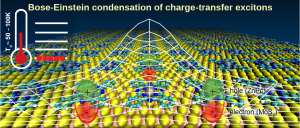
A Bose-Einstein condensate is an exotic state of matter in which all particles have the same energy and are completely coordinated. The Nobel Prize in Physics 2011 was awarded for the realisation of Bose-Einstein condensation (BEC) in a collection of rubidium atoms cooled to an ultra-low temperature of 20 nanoKelvins (nK).
However, the Bose-Einstein condensate is quite elusive. Because the BEC temperature increases with decreasing particle mass, one approach to increasing its temperature is to use particles with smaller mass, such as excitons (bound electron-hole pairs induced by optical excitation). However, achieving BEC of excitons is challenging because excitons are metastable and BEC is further hindered when the excitons have finite momentum.
Using state-of-the-art computations, Assoc Prof Quek Su Ying and her postdoctoral fellow Dr Uiman Kanchan predicted that BEC can take place at around 50 K to 100 K in organic two-dimensional (2D) material systems. This BEC temperature is orders of magnitude higher than that previously achieved using atoms. The particles that condense in the 2D materials systems are bound electron-hole pairs (excitons) that are induced through light irradiation. These charge transfer excitons, with electrons and holes in separate layers that result in long exciton lifetimes, are critical for BEC to take place.
Their prediction paves the way for more practical realisations of BEC.
This work was published in Nano Letters (October 2021).

